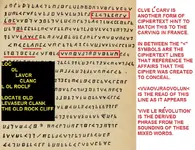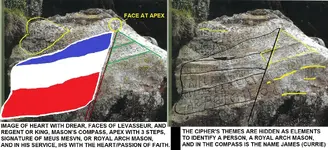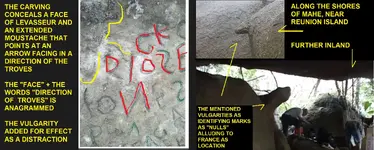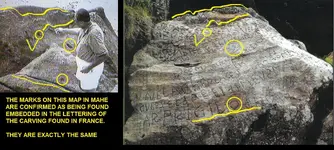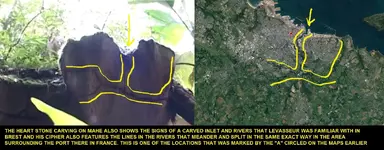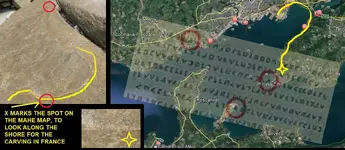If anyone is here?
Does any one know where I can find high res of the Original(original copy) The ones on the internet I found are no good now I need to see the one from the archievs on Mahe.
Eldo
I'd love to hear you reasoning for connecting the stone the Cipher. Is there anything that directly relates the two? I dont feel comfortable with the ship halves. The way you pick out 'clue' is obscure, I doubt that word be used in that way. Also I can say the same text could be a referance to the Etiane from the letter, Calliere. I understand the possible resoning and have also found la roc in my squares along with those 3 towns which if you draw a line connecting makes the triangle from the flat 'A's in the chiper. Paris is a better match but it does line up with brest.... ;p
If the stone is a key to the Cipher is it usable? I can not find a copy of the inscription only poor photographs.
I have been working with a couple of groups of key words in a kind vigenere fashion.
there is an annagram of the word 'square' in the second line next to, and sharing charecters with a word very closer to 'Durer'. These two together Could be taken for a clue to use a square in a certain fashion. (No evidence for this thoery. apart from the symbolism and possibly coincidence)
Also if you take the first word 'Apre' to mean harsh to hear, and the obscure word TIRESKET. Dropping the T's makes 'IRESKE' which is Danish for 'Irish' and danish being a hard language to hear for none speakers due to the unfarmilar vocalisations. This could be a hint to multi language use in the cipher. Also hints that some key words to begin the journey are sat within matching chacters,within Pair's. Unfortunatly I doubt this method will bring me 'plain as day' clear text, more groups of letters that infer a word so this can't be trusted but I have follow afew of the trails and the squares have hinted at boats frozen or stuck in a harbour that are burnt. plunder and troves. Cpt, Jim, Cpt Johnhon, brother Elfoe, Hawken. One interesting dechiperd text was CLPASMS, as in 150 psalms, I think, this is a hint to those that know that chiper is to be read three ways. Also the name demolay. Until I can find a copy of the original document or go and Photo graph it myslef( if I can find it! Any help welcome) I can't continue much further. past to the second wall.
I do believe the text has been alterd many many times Possibly as the other troves were collected? I think This Chipher is very old, has been re worked several times, may never be sovled due to coruption with out the original.
it has been cleaned of charcters
there are 4 maybe 5 chiphers on the page one chiper has certainly been alterd .
I believe the document was first 'repurposed' in 1426.
The original document has a signature.
I do think there are four troves left if you read how the Chipher has been reworked over time you will see there was a total of 36 of which four are still left, maybe 3 now?
I think if LBT is on mahe and can walk around Im sure he wouldnt need a map I have seen very good locations from air photographs but will likley never step foot on the island. and without the eye stone it could be difficult.........
1110 11010
The stone slab with letters has the words at the top line ROCAR..... in the Cipher one of the lines shows the phrase as well....each of the clues to look for has a familiar < > surrounding it as a dual feature, meaning the entire cipher can be read with the masonic pig pen but certain words are set up in these segments that are used to hint at keywords to form a sort of narrative description of the rock itself and the other markings as well
Take a look at how many of them are found together in France. All of the symbols found in the cipher can be found on the rock in some fashion.
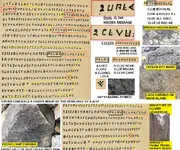
If you saw that the cipher was describing the stone along the coast of France (which nobody noticed) you would naturally look there, and it was archived in the French Naval History Museum, but was unbroken except with the Pig Pen so they just labeled it "LeVasseur". The story we all have been shown then immediately moved to Mahe "in pursuit" of his treasures, as there was a man there that had discovered a map on the shores and began an excavation. Using this map someone came along and gig jumped Wilkins and took on the adventure to the mountain cave where they were confronted by the fallacy of the idea that he had stashed it on the island, seeing his name and more carvings on the hill. This was merely a location of mapping stones he had crafted to show where the final resting place was to find his troves.
The carvings on Mahe depict the maps from the areas in Plougastel Daoulas and Brest as pointers to where the treasure was initially taken...he was merely hiding out there in safety but had already stashed the troves in France, crafting the maps. It was clearly said that after his raid on the Portuguese Ship that they left together but separated with Taylor leaving on his own ship to the coast of Mexico. Levasseur was not seen for 8 or 9 years it was said after that. Plenty of time to bring the troves back to France one by one and buy time during the conflicts.
My reasoning is that when you get to where Levasseur was stationed he was a known figure there in Brest, so he also knew the region well. Moving to follow his trail on his adventures you find a series of maps carved in stone on one island along the shores that lead you to the cave on the hillside with his signature. Nothing else was said about him, other than the attempt to pin that cipher on him, but why would the cipher be attributed to his penmanship and considered THE same cipher from his execution IF the cipher clearly reads LOC OL LAVCR CLANC?
These are the two known locations on Mahe of maps that depict the location of his troves. But the funny part is that they really show the region in France around where his old port was located. So he was using this a way to show you where to look IN FRANCE.
The Mahe markings are "signature" meaning that they are signed by him but they also are cryptic, meaning there is a deception involved to ward off hunters of his trove. The cipher being found is suspect on it's own as that amount of paper in a locket on his necklace was not really possible, and it would have been a smaller piece of paper wrapped inside of it. So to find who made the cipher?
Look at the rock for the dates....
The bottom left hand side says 1786.....three years before the French Revolution
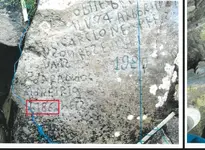
Then the "Me James" "MEUS MESUN"section by the Masons Compass and Square on the right side...Meus is Arch in Latin.....ME JAMES, ARCH MASON...his signature.
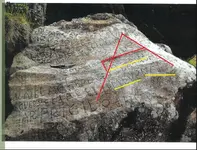
This is the signature of the man that made the cipher in the stone, James Currie, a well traveled doctor, and the personal physician of Thomas Jefferson
They were working simultaneously while planning through their letters to one another. Jefferson went to France to speak to the French Lodges, stirring up the movement and the initial plans for the takeover of France, then wrote to Curry with plans in letters. Then Curry responded in a letter to set up the OK, and then Jefferson returned to the US with Currie traveling to France to carve the stone, leaving instructions for the French Freemasons to start the Revolution with the troves discovered. They must have had the initial cipher then and left this behind in the archives somehow with the instructions clearly labeled on it
Look how the descending order of the steps in the text on the left are mimicking the path to the stone at Plougastel and then highlight the L' OL ROCLF beneath it....as you find the rock on the waterfront you are faced with the text VVAOVJRAOVOLUN as you see the flag carved there with the map and the other marks that are found on the ciphers. It's old but it's there.
